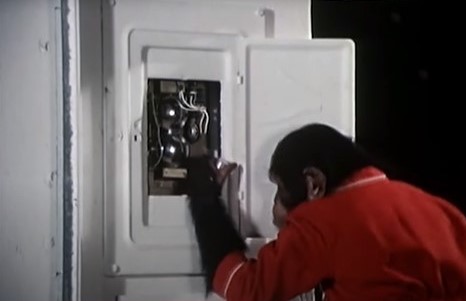 In an episode of “Space Academy” called “Monkey Business,” a solar mirror at an agricultural lab fails and only Jake, a chimpanzee, can climb the tower to make the repair. Guided by telepathic instructions from Laura (my role), Jake scales the tower and saves the day.
In an episode of “Space Academy” called “Monkey Business,” a solar mirror at an agricultural lab fails and only Jake, a chimpanzee, can climb the tower to make the repair. Guided by telepathic instructions from Laura (my role), Jake scales the tower and saves the day.
It broke my heart to work with Jake. When the poor chimp was not on the set, he was locked in a cage barely larger than he was. He looked so sad, and even when he was on the set, he still looked sad and confused. He wasn’t at all enthusiastic about climbing the “tower” (really a succession of props that, when the shots were edited, created the impression of a tall tower). Apes and monkeys are not stunt performers and shouldn’t be forced to be.
The plight of primates (apes and monkeys) is so much worse than simply being forced to grin and perform on Hollywood sets. At this moment, thousands of primates are languishing in cages, living in fear, and being denied everything that’s natural and important to them. These complex, intelligent, and sociable animals will be tortured and killed in crude, cruel, and useless experiments conducted in university, government, and private laboratories.
Numerous investigations have found that in order to abduct primates from their homes in the wild, trappers often shoot mothers from trees, stun the animals with dart guns, and then capture the babies, who cling, panic-stricken, to their mothers’ bodies. Some wildlife traders catch whole primate families in baited traps. The animals are packed into tiny crates with little to no food or water and are taken to filthy holding centers, where they await long and terrifying trips in the cargo holds of passenger airliners. Their destination: laboratories like Covance or Charles River Laboratories, laboratory dealers like Primate Products, Inc., or primate breeding centers.
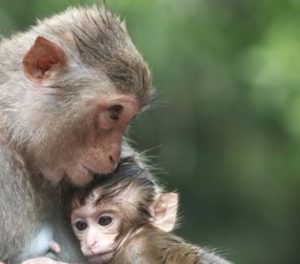
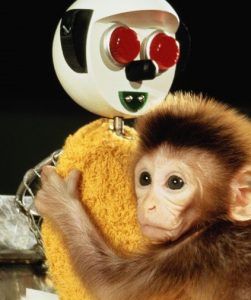 Torn from their families and social groups, these traumatized primates are typically confined to barren steel cages—a far cry from the lush forests and savannahs of their native habitat. At home, nonhuman primates travel for miles, foraging for a variety of foods, socializing with family and friends, climbing hills, swinging from vines, swimming in rivers, scampering across fields, and cavorting with their companions. In laboratories, these animals have barely enough room to sit, stand, lie down, or turn around. The rich days full of sensory stimulation that they should be experiencing are replaced by days that are devoid of color, scent, and almost every other type of environmental enrichment. At most, the primates in laboratories are given cheap plastic toys, scratched mirrors, and the occasional slice of apple or banana. Research shows that 90% of primates in laboratories exhibit abnormal behaviors caused by abuse, stress, and social isolation. Many go insane, rocking back and forth, pacing endlessly in the cages, and engaging in repetitive motions such as back-flipping. They even engage in acts of self-mutilation, including tearing out their own hair or biting their own flesh.
Torn from their families and social groups, these traumatized primates are typically confined to barren steel cages—a far cry from the lush forests and savannahs of their native habitat. At home, nonhuman primates travel for miles, foraging for a variety of foods, socializing with family and friends, climbing hills, swinging from vines, swimming in rivers, scampering across fields, and cavorting with their companions. In laboratories, these animals have barely enough room to sit, stand, lie down, or turn around. The rich days full of sensory stimulation that they should be experiencing are replaced by days that are devoid of color, scent, and almost every other type of environmental enrichment. At most, the primates in laboratories are given cheap plastic toys, scratched mirrors, and the occasional slice of apple or banana. Research shows that 90% of primates in laboratories exhibit abnormal behaviors caused by abuse, stress, and social isolation. Many go insane, rocking back and forth, pacing endlessly in the cages, and engaging in repetitive motions such as back-flipping. They even engage in acts of self-mutilation, including tearing out their own hair or biting their own flesh.
Besides having their most fundamental needs and desires disregarded, primates imprisoned in laboratories are subjected to painful and traumatic procedures, including having tubes forced up their nostrils or down their throats so that experimental drugs can be pumped into them. The National Institutes of Health, it should be added, reports that animal tests have a 95% failure rate in predicting the safety and/or effectiveness of pharmaceuticals, making them pointless as well as cruel.
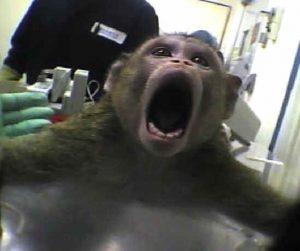 Rhesus monkeys are given infectious diseases and then used as test subjects for experimental vaccines. Even though decades of these experiments on primates have failed to produce effective vaccines for humans, monkeys are still infected with HIV-like diseases that cause them to suffer acute weight loss, major organ failure, breathing problems, and neurological disorders before they die excruciatingly painful deaths or are killed.
Rhesus monkeys are given infectious diseases and then used as test subjects for experimental vaccines. Even though decades of these experiments on primates have failed to produce effective vaccines for humans, monkeys are still infected with HIV-like diseases that cause them to suffer acute weight loss, major organ failure, breathing problems, and neurological disorders before they die excruciatingly painful deaths or are killed.
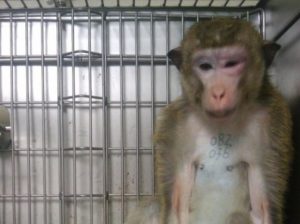 In recent experiments conducted by the military, primates were exposed to anthrax and infected with botulism and bubonic plague. In archaic chemical casualty training exercises, squirrel monkeys were poisoned with nerve agents that caused them to convulse, even though human-patient simulators exist and provide more effective training.
In recent experiments conducted by the military, primates were exposed to anthrax and infected with botulism and bubonic plague. In archaic chemical casualty training exercises, squirrel monkeys were poisoned with nerve agents that caused them to convulse, even though human-patient simulators exist and provide more effective training.
Monkeys are torn from their mothers in order to cause psychological trauma and examine the harm that results. After 50 years of these studies, don’t we know enough already about the effects of maternal deprivation?
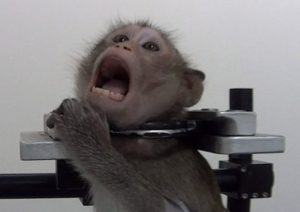 In invasive brain experiments, monkeys have holes drilled into their skulls, metal restraints screwed into their heads, and electrodes inserted into their brains. Experimenters at Columbia University caused strokes in baboons by removing their left eyeballs and using the empty eye sockets to clamp critical blood vessels leading to their brains. Some animals have portions of their brains destroyed or removed to impair their cognitive function or cripple them. These sensitive, intelligent animals then have their bodies immobilized in restraint chairs and their heads bolted into place as they are forced to perform a variety of behavioral tasks while their brain activity is recorded. In order to coerce the monkeys to cooperate, they are sometimes deprived of water for up to 24 hours at a time. When the experiments conclude, most of the animals are killed and their brains are removed and dissected.
In invasive brain experiments, monkeys have holes drilled into their skulls, metal restraints screwed into their heads, and electrodes inserted into their brains. Experimenters at Columbia University caused strokes in baboons by removing their left eyeballs and using the empty eye sockets to clamp critical blood vessels leading to their brains. Some animals have portions of their brains destroyed or removed to impair their cognitive function or cripple them. These sensitive, intelligent animals then have their bodies immobilized in restraint chairs and their heads bolted into place as they are forced to perform a variety of behavioral tasks while their brain activity is recorded. In order to coerce the monkeys to cooperate, they are sometimes deprived of water for up to 24 hours at a time. When the experiments conclude, most of the animals are killed and their brains are removed and dissected.
Experiments on primates, like those performed on any animal, are cruel, painful, and ultimately deadly. Some primates differ in DNA from humans by only 3%. You could say they are our closest relatives on this planet. So why do we insist on torturing and killing them?
Peace to ALL the animals with whom we share this planet!
